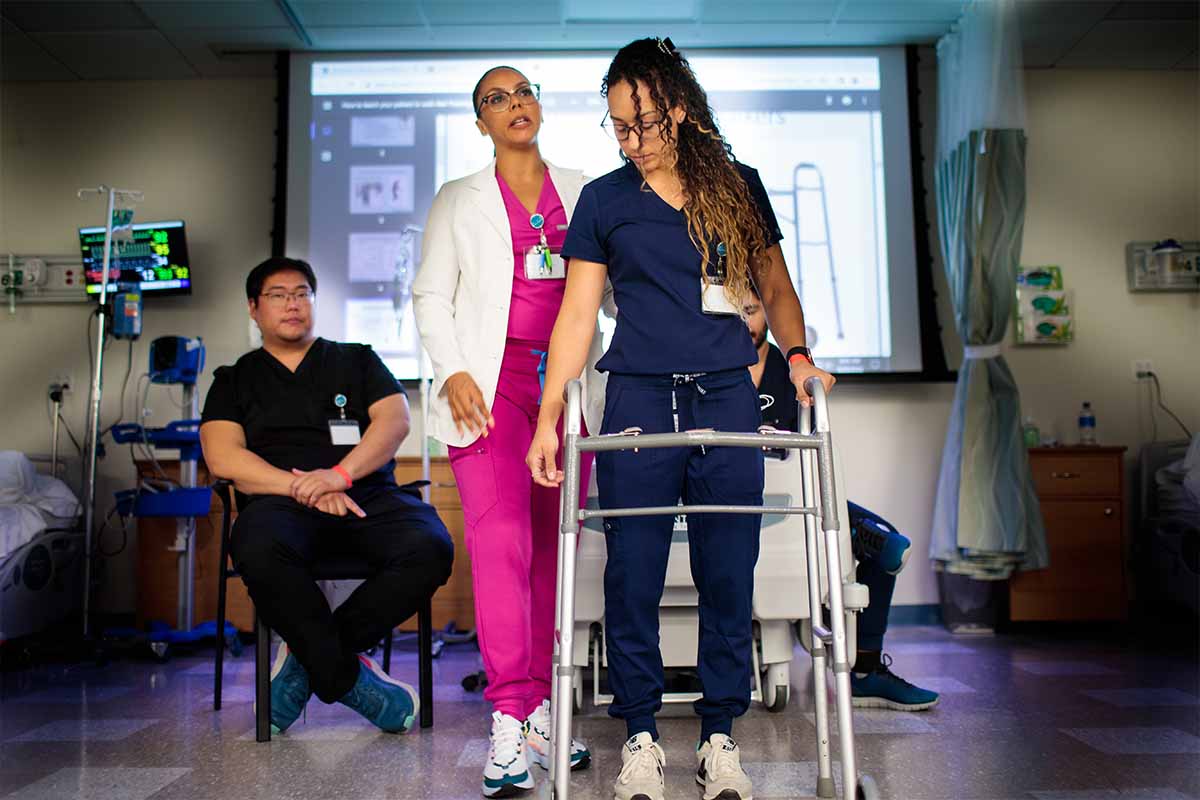

If you’ve ever felt called to work in rehabilitative care, one thing is clear: you’re passionate about helping others. What may not be quite as clear is which form of patient therapy you should pursue—occupational therapy (OT) or physical therapy (PT).
Both physical therapists (PTs) and occupational therapists (OTs) help patients improve their lives, but there is one essential difference: A physical therapist’s job is to help people improve their movement and manage pain after an injury, while an occupational therapist helps people with daily living skills.1,2


For example, a person recovering from knee surgery would see a physical therapist to help them regain range of motion and minimize pain related to bending the knee. Someone who has had a stroke would see an occupational therapist to relearn how to get dressed.
We break down the differences between physical and occupational therapy so you can choose the right path for you.
Table of Contents:
- OT vs. PT: Other Differences
- Occupational Therapy vs. Physical Therapy: Which Is Right for Me?
- Prepare to Become an OT or PT at USAHS
OT vs. PT: Other Differences
There are some additional differences between occupational and physical therapists beyond their job description.
Job Responsibilities
An occupational therapist has many job responsibilities. In general, you can expect to do the following2:
- Review a patient’s medical history
- Develop personalized treatment plans for patients
- Help patients relearn daily living tasks or learn to do them in a new way
- Demonstrate exercises and movements for patients
- Conduct setting accessibility evaluations to identify how environments can be improved to help the patient
- Counsel patients’ families about how to accommodate their needs
- Recommend adaptive equipment and teach patients how to use it
- Monitor patient progress over time



A physical therapist’s job responsibilities are similar1:
- Review a patient’s medical history
- Observe patient movements and listen to them share their concerns to diagnose movement functions
- Develop individualized treatment plans to address a patient’s movement issues
- Design and demonstrate exercises, stretches, hands-on therapy and equipment to increase a patient’s mobility, ease pain and prevent further pain or injury
- Monitor a patient’s progress toward goals
- Counsel patients and families about recovery;
- Teach patients to use adaptive equipment (canes, crutches, etc.) to improve mobility and decrease pain/li>
Both occupational and physical therapists work in nursing facilities, hospitals, office settings. K-12 schools and home healthcare.3,4,5 Physical therapists often work in residential care facilities or are self-employed.4
H3: Conditions Treated
Both occupational and physical therapists treat a wide range of conditions.
| Conditions Occupational Therapists Treat2,6 | Conditions Both Occupational Therapists and Physical Therapists Treat 1,2,6,7,8 | Conditions Physical Therapists Treat 1,7,8 |
|---|---|---|
|
|
|
A patient may receive treatment from an occupational therapist and physical therapist for the same condition.9 For example, a patient recovering from a stroke may see an occupational therapist for help dressing their upper body, while a physical therapist may help them regain core stability to prevent falls.
Education Requirements
The main difference between becoming an occupational therapist or a physical therapist is the type of degree and how long it will take you to become an OT or PT.
To become an occupational therapist, you’ll likely need to do the following:
- Earn a bachelor’s degree.10 Your bachelor’s may not need to be in a particular subject, but make sure you’ve completed the prerequisites required by your graduate program.11 (Note that some institutions, like the University of St. Augustine for Health Sciences (USAHS), may have an alternate pathway that allows you to skip this step if you have one year of full-time work experience as an occupational therapist assistant (OTA) and enroll in an OTA to MOT bridge program.)
- Complete observation hours and take the GRE (if required by your program).10 Some programs may require observation hours with a licensed occupational therapist and/or a GRE score for admission. (USAHS does not require either.)
- Earn an advanced degree.11 A Master of Occupational Therapy (MOT) is an entry-level degree for occupational therapists. Or, you could earn a Doctor of Occupational Therapy (OTD), which prepares you more for leadership and research positions.12 The MOT takes about two years to completeTime to completion may vary by student, depending on individual progress, credits transferred and other factors., while the OTD takes about 2.7 years.Time to completion may vary by student, depending on individual progress, credits transferred and other factors.
- Pass the National Board for Certification in Occupational Therapy (NBCOT) exam.11 Every state requires a passing score on the NBCOT for licensure. Once you pass your exam, you are certified to practice as an occupational therapist.
- Get your license.11 All states require occupational therapists to be licensed, but requirements vary. In general, you can expect to submit to a background check and supply transcripts from your graduate program and your NBCOT score.10



To become a physical therapist, most people follow the steps below:
-
- Earn a bachelor’s degree.13 The exact subject isn’t critical, but earning your degree in one of the best undergraduate degree programs for physical therapists will minimize the additional prerequisite courses you’ll need to take before enrolling in your graduate program.
- Earn a Doctor of Physical Therapy (DPT) degree.13 Completing this entry-level degree for physical therapists typically takes 2.7 years.Time to completion may vary by student, depending on individual progress, credits transferred and other factors.
- Pass the National Physical Therapy Examination (NPTE).14 This exam evaluates your knowledge and skills related to physical therapy.
- Get your license.14 The requirements for licensure vary by state.



Specialties and Certifications
If you want to deepen your knowledge in occupational or physical therapy after you earn your entry-level degree, you can continue your education with specialty certifications. There are 10 physical therapy specialties and more than 20 occupational therapy specialties to choose from.
| Occupational Therapy Specialties 15,16 |
Physical Therapy Specialties17 |
|---|---|
|
|
Criteria for earning certifications vary by specialty, so make sure to consult the relevant certification board.15,16,17
Salary and Job Outlook
Occupational therapy and physical therapy are both promising occupations. Both have median salaries above the national average of $63,795 and are growing faster than the average for all occupations. 18,19,20
| Role | Median Salary | Job Outlook |
|---|---|---|
| Occupational Therapist | $93,180 21 |
About 9,600 annual openings expected through 2032 19 |
| Physical Therapist | $97,720 22 |
About 13,900 annual openings expected through 2032 20 |
Occupational Therapy vs. Physical Therapy: Which Is Right for Me?
Whether you become an occupational or physical therapist should depend on what you want to do: help patients improve their movement or their ability to complete basic tasks.



Occupational therapy is a good career with a substantial salary and a strong job outlook, as is physical therapy. Both roles are integral to a patient’s overall health and well-being, and you have the potential to change someone’s life for the better.
Prepare to Become an OT or PT at USAHS
If you’re considering a career in occupational or physical therapy, earn an advanced degree at USAHS.
Our occupational and physical therapy degree programs include blended learning for the perfect balance of convenience and hands-on experience. Our expert faculty-practitioners will help you navigate our interprofessional education programs that prepare you to work on a collaborative healthcare team. Practice your skills in our simulation labs with the latest state-of-the-art technology, one of the few in the country dedicated to rehabilitative science programs.
Reach out for more information about our programs, or apply today.
Sources:
- Bureau of Labor Statistics, “Physical Therapists: What Physical Therapists Do,” Occupational Outlook Handbook, last modified December 2023, https://www.bls.gov/ooh/healthcare/physical-therapists.htm#tab-2.
- Bureau of Labor Statistics, “Occupational Therapists: What Occupational Therapists Do,” Occupational Outlook Handbook, last modified December 2023, https://www.bls.gov/ooh/healthcare/occupational-therapists.htm#tab-2.
- Bureau of Labor Statistics, “Occupational Therapists: Work Environment,” Occupational Outlook Handbook, last modified December 2023, https://www.bls.gov/ooh/healthcare/occupational-therapists.htm#tab-3.
- Bureau of Labor Statistics, “Physical Therapists: Work Environment,” Occupational Outlook Handbook, last modified December 2023, https://www.bls.gov/ooh/healthcare/physical-therapists.htm#tab-3.
- American Physical Therapy Association, “School-Based Physical Therapy,” American Physical Therapy Association, https://www.apta.org/your-practice/practice-models-and-settings/school-based-physical-therapy.
- Cleveland Clinic, “Occupational Therapist,” Cleveland Clinic, last modified January 2023, https://my.clevelandclinic.org/health/articles/24617-occupational-therapist.
- Cleveland Clinic, “Physical Therapist,” Cleveland Clinic, last modified January 2023, https://my.clevelandclinic.org/health/articles/24625-physical-therapist.
- Explore Health Careers, “Physical Therapist,” Explore Health Careers, https://explorehealthcareers.org/career/physical-therapy/physical-therapist/.
- Clarice Grote, “Can OT and PT Co-Treat in Acute Care?” Amplify OT, last modified May 2023, https://amplifyot.com/can-occupational-therapy-and-physical-therapy-co-treat-in-acute-care/.
- Nalea Ko, “How to Become an Occupational Therapist,” Best Colleges, last modified October 19, 2023, https://www.bestcolleges.com/healthcare/how-to-become-an-occupational-therapist/.
- Bureau of Labor Statistics, “Occupational Therapists: How to Become an Occupational Therapist,” Occupational Outlook Handbook, last modified December 2023, https://www.bls.gov/ooh/healthcare/occupational-therapists.htm#tab-4.;
- USAHS, “Comparing the MOT vs. OTD Degrees,” USAHS, last modified February 2023, https://www.usa.edu/blog/mot-vs-otd/ .
- American Physical Therapy Association, “Becoming a PT,” American Physical Therapy Association, https://www.apta.org/your-career/careers-in-physical-therapy/becoming-a-pt.
- Bureau of Labor Statistics, “Physical Therapists: How to Become a Physical Therapist,” Occupational Outlook Handbook, last modified December 2023, https://www.bls.gov/ooh/healthcare/physical-therapists.htm#tab-4.
- American Occupational Therapy Association, “AOTA’s Advanced Certification Program,” American Occupational Therapy Association, https://www.aota.org/career/advanced-certification-program.
- USAHS, “20+ Occupational Therapy Specialties to Advance Your Career,” USAHS, last modified July 2022, https://www.usa.edu/blog/occupational-therapy-specialties/.
- American Physical Therapy Association, “Become an ABPTS-Certified Specialist,” American Physical Therapy Association, https://specialization.apta.org/become-a-specialist.
- Social Security Administration, “National Average Wage Index,” Social Security Administration, https://www.ssa.gov/oact/cola/AWI.html.
- Bureau of Labor Statistics, “Occupational Therapists: Job Outlook,” Occupational Outlook Handbook, last modified December 2023, https://www.bls.gov/ooh/healthcare/occupational-therapists.htm#tab-6.
- Bureau of Labor Statistics, “Physical Therapists: Job Outlook,” Occupational Outlook Handbook, last modified December 2023, https://www.bls.gov/ooh/healthcare/physical-therapists.htm#tab-6.
- Bureau of Labor Statistics, “Occupational Therapists: Pay,” Occupational Outlook Handbook, last modified December 2023, https://www.bls.gov/ooh/healthcare/occupational-therapists.htm#tab-5.
- Bureau of Labor Statistics, “Physical Therapists: Pay,” Occupational Outlook Handbook, last modified December 2023, https://www.bls.gov/ooh/healthcare/physical-therapists.htm#tab-5.








